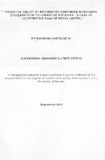| dc.contributor.author | Macharia, Caroline W | |
| dc.date.accessioned | 2013-05-15T06:51:55Z | |
| dc.date.available | 2013-05-15T06:51:55Z | |
| dc.date.issued | 2003 | |
| dc.identifier.citation | A Management Research Project Report Submitted in Partial Fulfillment for the Requirements of the Degree of Masters of Business Administration (MBA), School Of Business, University Of Nairobi | en |
| dc.identifier.uri | http://erepository.uonbi.ac.ke:8080/xmlui/handle/123456789/22818 | |
| dc.description.abstract | The study seeks to establish whether information contained in financial statements is
useful in discriminating between performing and non performing co-operative societies'
loans. Non performing loans, a prevalent occurrence to financial institutions, cause concern.
Central Bank of Kenya recently disclosed that t he ration 0 f non-performing loans to total
loans stood at a high of 23.4percent as at June 2004.
Credit evaluation data, quality information and choice of a reliable credit evaluation
model are key factors in enhancing credit evaluation and monitoring processes. An earlier
study found out that only 6.4percent of the commercial banks in Kenya use quantitative credit
risk assessment methods.
Financial statements contain information about solvency, profitability and financial
strength of a firm, useful in the prediction of future performance. Dicriminant analysis is a
way of classifying observations into 0 ne of several a priori groupings. It is used tom ake
predictions where the dependent variable appears in qualitative form, performing or non
performing. It is used to find the linear combination of observations that maximize the
variance between groups relative to t he variances within the group. The data used in this
study is derived from financial statements of co-operative societies in Kenya.
The findings of this study indicate that we can rely on discriminant model and the
ratios that are an input to that model to separate performing co-operative societies from nonperforming
ones. | en |
| dc.language.iso | en | en |
| dc.title | Predictive Ability of Information Contained in Financial Statements of Co-operative Societies - a Case of Co-operative Bank of Kenya Limited | en |
| dc.type | Thesis | en |
| local.publisher | Business Administration | en |

